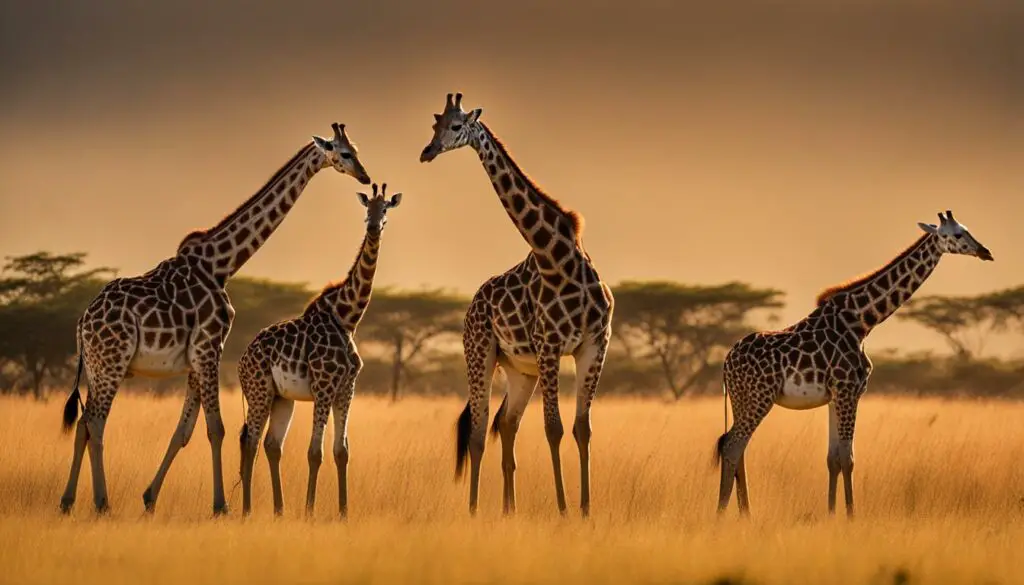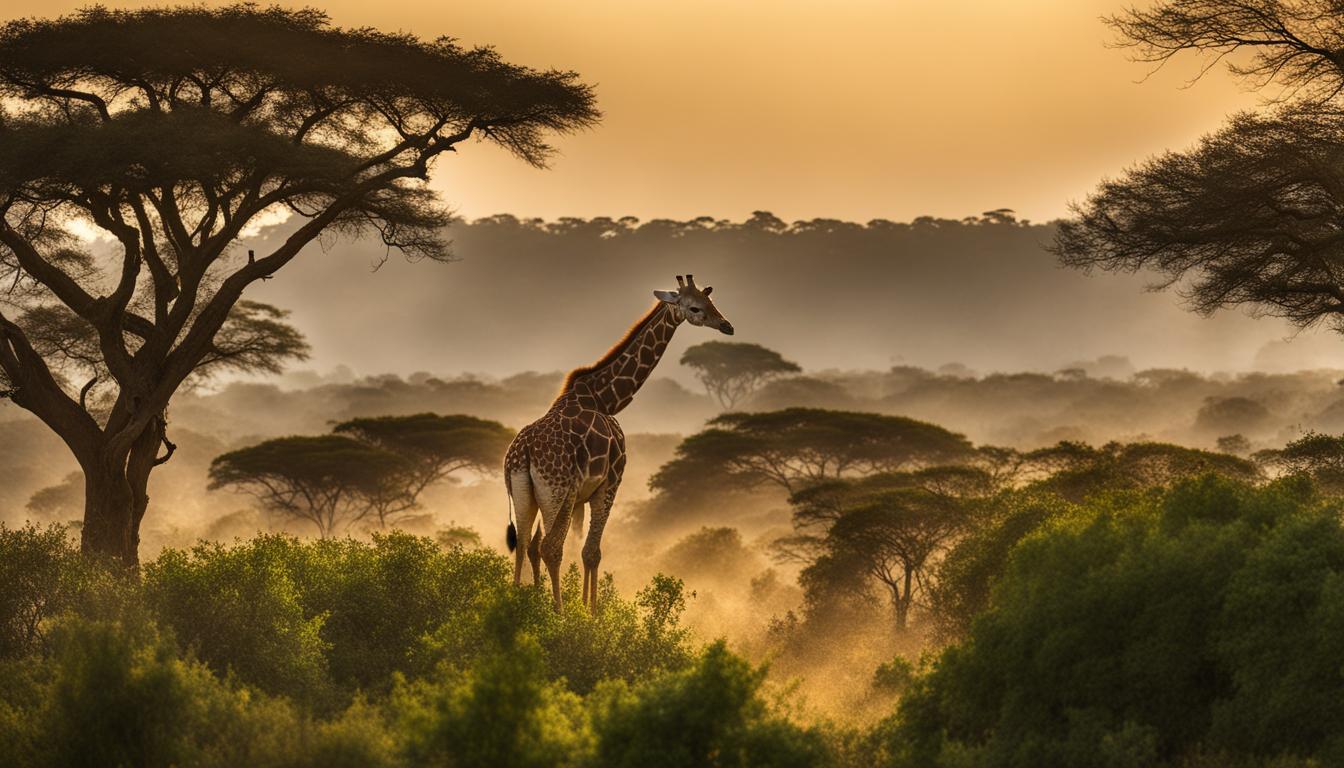Have you ever wondered just how tall giraffes can grow? Well, get ready to be amazed by these magnificent creatures! Giraffes are the tallest living land animals, reaching heights that will leave you in awe. Males can grow up to a staggering 18 feet, while females can reach heights of up to 14 feet. That’s taller than most trees!
But it’s not just their overall height that’s impressive. Giraffes also have long necks that can reach up to 6 feet in length, weighing as much as 600 pounds. Can you imagine having a neck that tall? It’s truly remarkable!
Giraffes are not only known for their height, but also for their unique appearance. They have a small hump on their back and a beautifully spotted coat. These patterns on their coat help them blend in with their surroundings and provide camouflage from predators.
Despite their towering height, giraffes are surprisingly agile. They can run at speeds of up to 34.7 miles per hour, making them one of the fastest land animals. And did you know that their hearts are a whopping 2 feet long and weigh 25 pounds? It’s incredible how these magnificent creatures are adapted to their extraordinary height!
So, next time you see a giraffe, take a moment to appreciate its incredible height and the amazing adaptations that come with it. Giraffes truly are nature’s skyscrapers!
The Importance of Giraffe Height in Survival
Giraffes, the tallest animals on land, owe their impressive height to their unique adaptation for survival. Their long necks, which can reach extraordinary lengths, serve multiple purposes in their daily lives.
The giraffe’s towering stature gives it a distinct advantage when it comes to finding food. While other herbivores struggle to access high branches, giraffes effortlessly reach leaves and foliage that are out of reach for most animals. This ability allows them to tap into food sources that would otherwise be inaccessible, ensuring their survival even in regions with limited vegetation.
Moreover, the giraffe’s height plays a vital role in maintaining safety from predators. With their elevated vantage point, giraffes can spot potential threats from a considerable distance, giving them ample time to react and evade danger. This keen sense of observation enhances their survival chances, making them less vulnerable to attacks from predators in their habitat.
Furthermore, the giraffe’s impressive height also serves as a means of communication and establishing social hierarchies within their groups. During confrontations, males use their necks as a weapon, swinging them forcefully in a display of dominance. This behavior helps maintain order within the herd and ensures that resources, such as access to food and mates, are distributed among individuals in a structured manner.
Tallest Animals on Land
| Animal | Average Height (Feet) | Average Height (Meters) |
|---|---|---|
| Giraffe | 18 | 5.5 |
| Elephant | 10 | 3 |
| African Elephant | 13 | 4 |
| White Rhinoceros | 6 | 1.8 |
When comparing giraffe height to other land animals, it becomes evident that giraffes truly stand out as the tallest. The average giraffe can reach heights of up to 18 feet (5.5 meters), dwarfing other large mammals such as elephants and rhinoceroses. This remarkable height reinforces the giraffe’s status as a unique and extraordinary creature in the animal kingdom.
Through their exceptional height, giraffes have secured their place as one of nature’s most remarkable creations. Their elongated necks and towering stature allow them to thrive in their environment, ensuring their survival through efficient foraging, effective predator detection, and the establishment of social order within their communities. As we continue to appreciate and understand the significance of giraffe height, we gain a deeper admiration for these majestic creatures that roam our lands.
Giraffe Habitat and Diet
Giraffes are found in a variety of habitats in sub-Saharan Africa, including savannas, grasslands, and woodlands. They can be seen in countries such as Kenya, Cameroon, Chad, Niger, and South Africa. These majestic creatures have adapted to different environments and can thrive in diverse ecosystems.
When it comes to their diet, giraffes are herbivores. They primarily feed on leaves, consuming an astonishing amount of up to 75 pounds of food per day. Their favorite leaves are often found on acacia trees, which are abundant in their habitats. Despite the thorny branches, giraffes have specialized tongues and saliva that allow them to reach and consume leaves without injuring themselves.
| Giraffe Habitat | Where Do Giraffes Live? |
|---|---|
| Savannas | Wide-open grassy plains with scattered trees and shrubs. |
| Grasslands | Vast areas covered with lush grasses. |
| Woodlands | Areas with more dense trees and vegetation. |
Giraffes’ ability to consume leaves from tall trees gives them a distinct advantage over other herbivores. While some animals struggle to reach high branches, giraffes can effortlessly access this food source. Their diet and unique adaptations have allowed them to thrive in their habitats and play a vital role in maintaining ecosystem balance.
Giraffe Reproduction and Social Structure
When it comes to reproduction, female giraffes have a gestation period of about 14 months. It’s a long wait, but the result is usually worth it – they give birth to one calf at a time. Something fascinating about giraffe births is that calves are born feet first, which helps them safely enter the world. Within hours of their birth, these little ones can already stand and walk, showcasing their incredible ability to adapt and survive.
While calves rely on their mothers for milk for the first six to nine months, they start to consume vegetation as early as four months old. This early introduction to their herbivorous diet helps them grow and develop at a steady pace. As they mature, giraffes live in social groups called “towers.” Tower members have a loose social structure, without strong social ties. However, mothers and their offspring form close bonds, supporting and caring for each other. Additionally, giraffes engage in social play and even have nursery groups where they take turns babysitting each other’s calves.
Giraffe Reproduction and Social Structure in Numbers:
| Fact | Value |
|---|---|
| Giraffe Gestation Period | Approximately 14 months |
| Average Number of Calves Born | 1 |
| Calves Ability to Stand and Walk | Within hours of birth |
| Duration of Nursing | 6 to 9 months |
| Age at Which Calves Start Consuming Vegetation | 4 months |
Giraffes’ unique reproductive process and social structure highlight their resilience and adaptability as a species. Despite the challenges they face in the wild, giraffes continue to thrive, showcasing the wonders of nature.

Giraffe Threats and Conservation Efforts
Giraffes, despite their impressive stature, face several threats that put their survival at risk. One of the main challenges is habitat loss due to human activities such as deforestation, agriculture, and infrastructure development. As their natural habitats shrink, giraffes have less space to roam and find food, leading to increased competition and vulnerability to predation.
Another significant threat to giraffes is poaching. These gentle giants are targeted for their meat, hides, and tails, which are highly valued in some cultures. Illegal hunting has contributed to a decline in giraffe populations, particularly in regions where law enforcement is limited.
Climate change also poses a risk to giraffes. Shifts in weather patterns and the increasing frequency of droughts can affect the availability of food and water sources. Giraffes must adapt to these changing conditions or face further challenges in their already precarious existence.
Conservation efforts are crucial to protecting giraffes and ensuring their long-term survival. Various organizations and initiatives are working tirelessly to address these threats and promote giraffe conservation.
One such organization is the Giraffe Conservation Foundation (GCF), which focuses on research, habitat protection, and community engagement. GCF works closely with local communities to raise awareness about the importance of giraffes and implement sustainable practices to mitigate human-wildlife conflicts.
Another key player in giraffe conservation is the San Diego Zoo Global. Through their collaborative partnerships with African governments and local conservation organizations, they support initiatives that protect giraffe populations and their habitats. Education and outreach programs are also integral to their efforts, empowering communities to become stewards of giraffe conservation.
By supporting these and other conservation efforts, we can help safeguard the future of giraffes and ensure that future generations can continue to marvel at these magnificent creatures.
Table: Giraffe Threats and Conservation Efforts
| Threats to Giraffes | Conservation Efforts |
|---|---|
| Habitat loss due to deforestation, agriculture, and infrastructure development | Collaborative efforts to protect and restore giraffe habitats, advocating for sustainable land-use practices |
| Poaching for meat, hides, and tails | Enhancing anti-poaching measures, strengthening law enforcement, promoting awareness and education to reduce demand for giraffe products |
| Climate change and its impact on food and water availability | Researching and implementing climate resilience strategies, supporting communities in adapting to changing environmental conditions |
Conclusion
Giraffes are truly remarkable creatures, mesmerizing us with their incredible height and unique adaptations. Their long necks and towering stature play a vital role in their survival, allowing them to access high branches for food and spot predators from a distance. They are the tallest animals on land, with their necks alone surpassing the height of the average human.
However, giraffes face numerous threats to their existence, including habitat loss, overgrazing, and poaching. As a result, their populations have declined, leading to their classification as Vulnerable on the IUCN Red List. It is crucial that we take action to protect these majestic animals and their habitats.
Conservation efforts are underway, with organizations like San Diego Zoo Global working tirelessly to support initiatives in Africa. By raising awareness, implementing sustainable practices, and supporting conservation organizations, we can make a difference in preserving the future of giraffes in the wild.
Do the Patterns and Markings on Giraffes Play a Role in Their Height and Growth?
Giraffe patterns and markings variation does not directly affect their height and growth. These unique markings serve as camouflage, providing them protection from predators. The intricate patterns also aid in identification and communication within their social groups. However, height and growth are primarily determined by genetics and other environmental factors.
FAQ
How tall can a giraffe grow, and how does it affect their life?
Giraffes can reach heights of up to 18 feet for males and 14 feet for females. Their height allows them to access high branches for food and spot predators from a distance.
What is the importance of giraffe height in their survival?
Giraffes’ tall stature gives them an advantage in finding food by reaching high branches. It also helps them spot predators, assert dominance, and establish social hierarchies within their groups.
Where do giraffes live and what do they eat?
Giraffes can be found in various habitats in sub-Saharan Africa, including savannas, grasslands, and woodlands. They are herbivores and primarily feed on leaves, with their favorite leaves found on acacia trees.
What is the reproduction and social structure of giraffes?
Female giraffes have a gestation period of about 14 months and typically give birth to one calf at a time. They live in herds called “towers” with a loose social structure. Mothers and their offspring form close bonds.
What threats do giraffes face and what is their conservation status?
Giraffes face threats such as habitat loss, overgrazing, and poaching. They are classified as Vulnerable on the IUCN Red List. Conservation efforts are underway to protect them, including education, supporting sustainable practices, and addressing issues like poaching and climate change.
Is there anything else I should know about giraffes?
Giraffes are fascinating creatures known for their impressive height and unique adaptations. Their tall stature allows them to thrive in their habitats and access food sources. Conservation efforts are crucial to protect these majestic animals and ensure their future in the wild.











